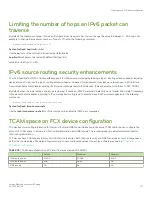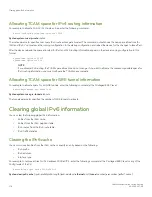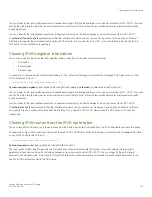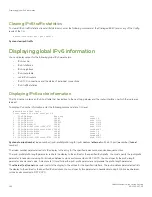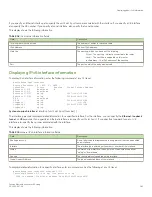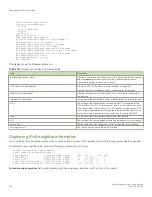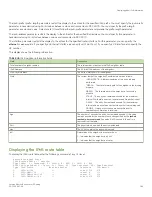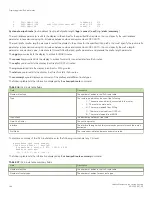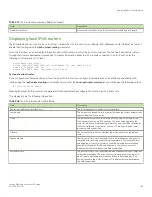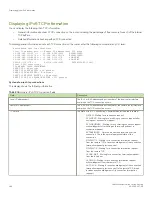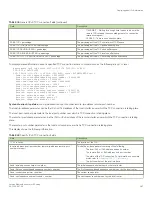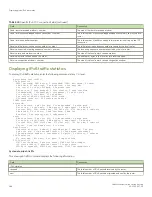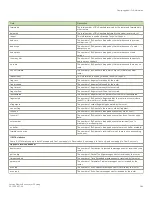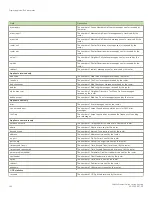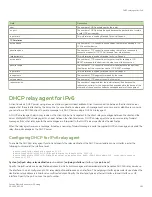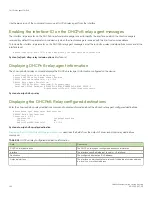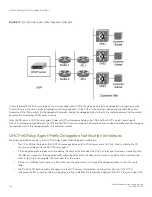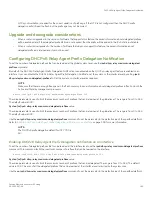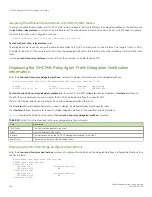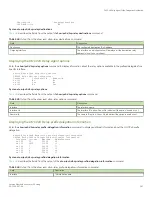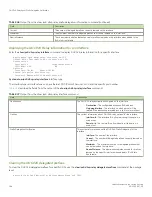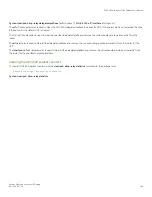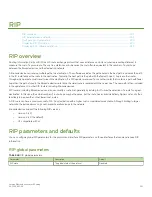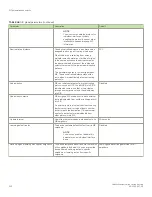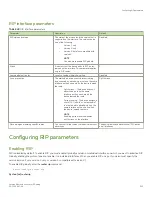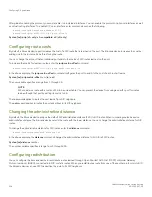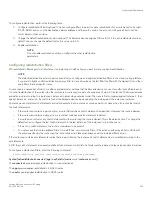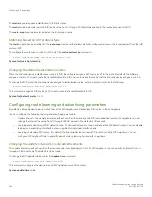
Field
Description
sent
The number of UDP packets sent by the router.
no port
The number of UDP packets dropped because the packet did not contain
a valid UDP port number.
input errors
This information is used by Brocade Technical Support.
TCP statistics
active opens
The number of TCP connections opened by the router by sending a TCP
SYN to another device.
passive opens
The number of TCP connections opened by the router in response to
connection requests (TCP SYNs) received from other devices.
failed attempts
This information is used by Brocade Technical Support.
active resets
The number of TCP connections the router reset by sending a TCP
RESET message to the device at the other end of the connection.
passive resets
The number of TCP connections the router reset because the device at
the other end of the connection sent a TCP RESET message.
input errors
This information is used by Brocade Technical Support.
in segments
The number of TCP segments received by the router.
out segments
The number of TCP segments sent by the router.
retransmission
The number of segments that the router retransmitted because the
retransmission timer for the segment had expired before the device at the
other end of the connection had acknowledged receipt of the segment.
DHCP relay agent for IPv6
A client locates a DHCP server using a reserved, link-scoped multicast address. Direct communication between the client and server
requires that they are attached by the same link. In some situations where ease-of-management, economy, and scalability are concerns,
you can allow a DHCPv6 client to send a message to a DHCP server using a DHCPv6 relay agent.
A DHCPv6 relay agent, which may reside on the client link, but is transparent to the client, relays messages between the client and the
server. Multiple DHCPv6 relay agents can exist between the client and server. DHCPv6 relay agents can also receive relay-forward
messages from other relay agents; these messages are forwarded to the DHCP server specified as the destination.
When the relay agent receives a message, it creates a new relay-forward message, inserts the original DHCPv6 message, and sends the
relay-forward message as the DHCP server.
Configuring DHCP for IPv6 relay agent
To enable the DHCPv6 relay agent function and specify the relay destination (the DHCP server) address on an interface, enter the
following command at the interface level:
device(config)# interface ethernet 1/2/3
device(config-if-e10000-1/2/3)#ipv6 dhcp-relay destination 2001::2
deviceconfig-if-e10000-1/2/3)#ipv6 dhcp-relay destination fe80::224:38ff:febb:e3c0 outgoing-interface
ethernet 1/2/5
Syntax:
[no] ipv6 dhcp-relay destination
ipv6-address
[
outgoing-interface
interface-type
port-num
]
Specify the
ipv6-address
as a destination address to which client messages are forwarded and which enables DHCPv6 relay service on
the interface. You can configure up to 16 relay destination addresses on an interface. The outgoing-interface parameter is used when the
destination relay address is a link-local or multicast address. Specify the interface-type as ethernet interface, tunnel interface, or VE
interface. Specify the port-num as the port number.
DHCP relay agent for IPv6
FastIron Ethernet Switch Layer 3 Routing
53-1003627-04
191
Summary of Contents for FastIron SX 1600
Page 2: ...FastIron Ethernet Switch Layer 3 Routing 2 53 1003627 04 ...
Page 16: ...FastIron Ethernet Switch Layer 3 Routing 16 53 1003627 04 ...
Page 20: ...FastIron Ethernet Switch Layer 3 Routing 20 53 1003627 04 ...
Page 142: ...FastIron Ethernet Switch Layer 3 Routing 142 53 1003627 04 ...
Page 150: ...FastIron Ethernet Switch Layer 3 Routing 150 53 1003627 04 ...
Page 200: ...FastIron Ethernet Switch Layer 3 Routing 200 53 1003627 04 ...
Page 214: ...FastIron Ethernet Switch Layer 3 Routing 214 53 1003627 04 ...
Page 350: ...FastIron Ethernet Switch Layer 3 Routing 350 53 1003627 04 ...
Page 476: ...FastIron Ethernet Switch Layer 3 Routing 476 53 1003627 04 ...
Page 588: ...FastIron Ethernet Switch Layer 3 Routing 588 53 1003627 04 ...

